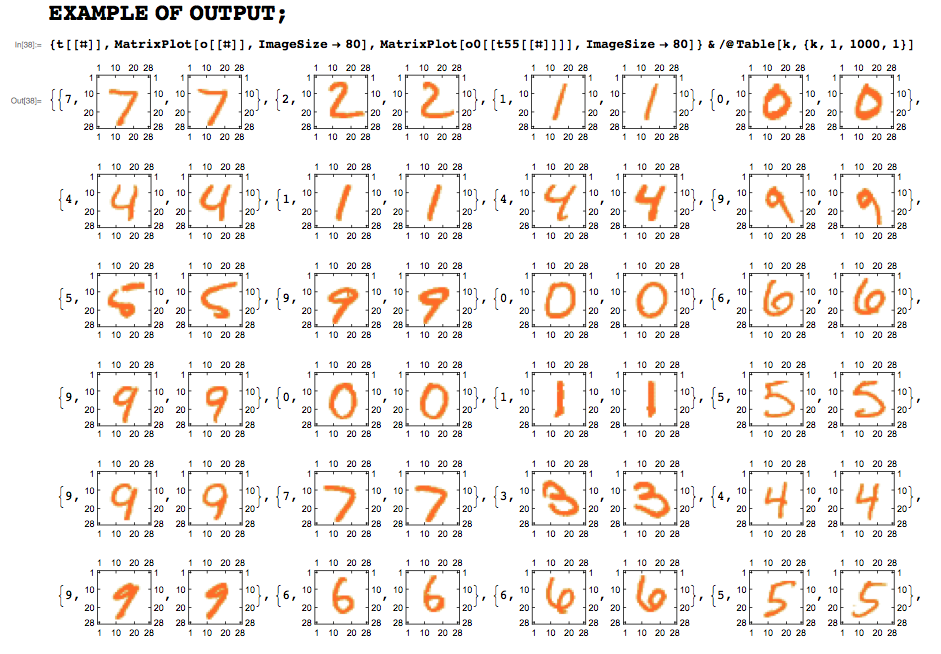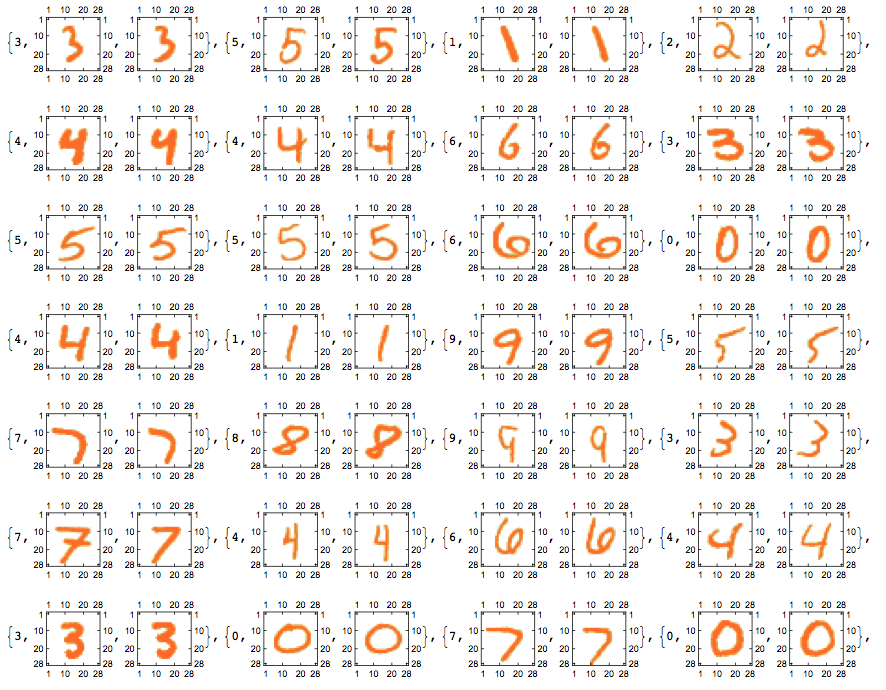During my learning process in Data Science I solved the MNIST task with Wolfram Mathematica, simply by calculating the difference of values in pixels of different digits. There are 10 classes: 0, 1, 2, 3, 4, 5, 6, 7, 8, 9 (target value) and each digit is a 28x28 pixels matrix (784 pixel values). The original dataset has 60,000 examples in training set and 10,000 examples in test set. Linear separator achieve 93% accuracy. The whole calculation took 3 hours.
Here is the code:
Clear["Global`*"]
SetDirectory[$UserDocumentsDirectory];
<<JLink`;
InstallJava[];
ReinstallJava[JVMArguments->"-Xmx2048m"]
TRAIN SET;
a0=Import["mnist_train.csv"];
{Dimensions[a0],Dimensions[Flatten[a0]]}
{{60000,785},{47100000}}
TEST SET;
a=Import["mnist_test.csv"];
{Dimensions[a],Dimensions[Flatten[a]]}
{{10000,785},{7850000}}
t0=a0[[#]][[1]]&/@Table[k,{k,1,Dimensions[a0][[1]],1}];
b0=Drop[a0[[#]],1]&/@Table[k,{k,1,Dimensions[a0][[1]],1}];
o0=Partition[b0[[#]],28]&/@Table[k,{k,1,Dimensions[a0][[1]],1}];
TEST SET;
t=a[[#]][[1]]&/@Table[k,{k,1,Dimensions[a][[1]],1}]
b=Drop[a[[#]],1]&/@Table[k,{k,1,Dimensions[a][[1]],1}];
o=Partition[b[[#]],28]&/@Table[k,{k,1,Dimensions[a][[1]],1}];
t2=Total[Abs[Flatten[o[[1]]]-Flatten[o0[[#]]]]]&/@Table[k,{k,1,Dimensions[o0][[1]],1}];
t3=Flatten[Position[t2,Min[t2]]];
f[x_]:=Flatten[Position[Total[Abs[Flatten[o[[x]]]-Flatten[o0[[#]]]]]&/@Table[k,{k,1,Dimensions[o0][[1]],1}],Min[Total[Abs[Flatten[o[[x]]]-Flatten[o0[[#]]]]]&/@Table[k,{k,1,Dimensions[o0][[1]],1}]]]];
t5=f/@Table[k,{k,1,Dimensions[t][[1]],1}];
t55=Flatten[If[Dimensions[t5[[#]]][[1]]>1,t5[[#]][[1]],t5[[#]]]&/@Table[k,{k,1,Dimensions[t5][[1]],1}]];
tt=t0[[#]]&/@Flatten[t55];
ACCURACY;
N[Count[t-tt,0]/Dimensions[t][[1]]]
0.9631
SAMPLE OF 1,000 OUTPUTS;
{t[[#]],MatrixPlot[o[[#]],ImageSize->80],MatrixPlot[o0[[t55[[#]]]],ImageSize->80]}&/@Table[k,{k,1,1000,1}]
Examples of the output are shown, left is test set digit and right predicted digit:

